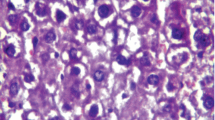Abstract
The distribution of 2,21,4,41,5,51-hexachlorobiphenyl-14C was studied in mice and Chinese Hamsters using whole body autoradiography and liquid scintillation counting. The mice exhibited a strong and persistent accumulation of radioactivity in the bronchial mucosa, and this accumulation was not fully developed until about 24 hrs after an intravenous injection. The labelled substance passed to the fetuses of pregnant mice and was also concentrated in the fetal bronchi. Mice pretreated with a large dose of unlabelled PCB per os in peanut oil showed a completely different distribution pattern in the lungs — only traces of label being taken up by the bronchi. Quantitative measurements revealed a concomitant reduction of the total radioactivity retained by the lungs. Except for the lungs, however, no major differences in the distribution pattern were found at the various dose levels. The distribution in the Chinese hamsters equaled approximately that of the mice, but a very weak accumulation of label was observed in the hamster bronchi. The radioactivity in the mouse bronchi was considered as perhaps representing metabolized PCB.
Zusammenfassung
Die Verteilung von 2,21,4,41,5,51-hexachlorobiphenyl-14C wurde an Mäusen und chinesischen Hamstern studiert, wobei Ganz-Tier-Autoradiographie und Flüssigkeits-Scintillations-Zählung verwendet wurden. Die Mäuse zeigten eine starke und lange persistierende Anhäufung von Radioaktivität in der Bronchialschleimhaut. Diese Anhäufung trat vollständig erst 24 Stunden nach einer intravenösen Injektion auf. Die radioaktive Substanz erreichte die Föten trächtiger Mäuse und fand sich auch in den fötalen Bronchien konzentriert. Mäuse, die mit einer großen Dosis von unmarkierten PCB per os in Erdnußöl vorbehandelt worden waren, zeigten ein völlig verschieden geartetes Verteilungsmuster in den Lungen — die Bronchien nahmen nur Spuren der markierten Substanz auf. Quantitative Messungen zeigten eine gleichzeitige Reduktion der von den Lungen zurückbehaltenen totalen Radioaktivität. Mit Ausnahme der Lungen wurden jedoch bei den verschiedenen Dosen keine großen Unterschiede im Verteilungsmuster gefunden. Die chinesischen Hamster wiesen die gleiche Verteilung wie die Mäuse auf. Es wurde aber nur eine sehr geringe Anhäufung der markierten Substanz in den Hamsterbronchien beobachtet. Die Radioaktivität in den Mausbronchien kann von metabolisiertem PBC stammen.
Similar content being viewed by others
References
Berlin, M., Gage, J., Holm, S.: Distribution and metabolism of 2,4,5,21,51-Pentachlorobiphenyl. Arch. environm. Hlth. 30, 141–147 (1975)
Brandt, I.: Distribution of 2,21,3,4,41,61- and 2,31,4,41,51,6-hexachlorobiphenyl in mice studied by whole body autoradiography. Toxicology 4, 275–287 (1975)
Hutzinger, O., Nash, D. M., Safe, S., De Freitas, A. S. W., Nordström R. J., Wildish, D. J., Zitko, V.: Polychlorinated bipehnyls: Metabolic behaviour of pure isomers in pigeons, rats, and brook trout. Science 178, 312–314 (1972)
Jensen, S., Johnels, A. G., Olsson, M., Otterlind, G.: DDT and PCB in marine animals from Swedish waters. Nature 224, 247–250 (1969)
Jensen, S., Sundström, G.: Structure and levels of most chlorobiphenyls in two technical PCB products in human adipose tissue. Ambio 3, 70–76 (1974a)
Jensen, S., Sundström, G.: Metabolic hydroxylation of a chlorobiphenyl containing only isolated unsubstituted positions — 2,21,4,41,5,51-hexachlorobiphenyl. Nature 251, 219–220 (1974b)
Koeman, J. H., Ten Noever de Brauw, M. D., de Vos, R. H.: Chlorinated bipehnyls in fish, mussels and birds from the river Rhine and the Netherlands coastal area. Nature 221, 1126–1128 (1969)
Melvås, B., Brandt, I.: The distribution and metabolism of labelled polychlorinated biphenyls in mice and quails. In: PCB conference II. National Swedish environment protection board. Publication 4E, pp. 87–100 (1973)
Moron, M., Sundström, G., Wachtmeister, C. A.: Polychlorinated biphenyls VI. 2,3,7,8-tetrachlorodibenzofuran, a critical byproduct in the synthesis of 2,21,4,41,5,51-hexachlorobiphenyl by the Ullmann reaction. Acta chem. scand. 27, 3121–3122 (1973)
Reid, W. D., Ilett, K. F., Glick, J. M., Krishna, G.: Metabolism and binding of aromatic hydrocarbons in the lung. Amer. Rev. respir. Dis. 107, 539–551 (1973)
Sissons, D., Welti, D.: Structural identification of polychlorinated biphenyls in commercial mixtures by gas-liquid chromatography, nuclear magnetic resonance and mass spectrometry. J. Chromatogr. 60, 15–32 (1971)
Sundström, G.: Polychlorinated biphenyls. V. Synthesis of 14C-labelled 2,21,4,41,5,51-hexachlorobiphenyl, a major component in PCB-mixtures. Bull. environ. contain. Toxicol. 11, 39–44 (1974)
Ullberg, S.: Studies on the distribution and fate of S35-labelled benzylpenicillin in the body. Acta radiol. (Stockh.) Suppl. 118, 7–110 (1954)
Ullberg, S.: Autoradiographic studies on the distribution of labelled drugs in the body. In: Second U.N. Int. Conf. Peaceful uses of atomic energy 24, pp. 248–254 (1958)
Ullberg, S., Appelgren, L.-E.: Experiences in locating drugs at different levels of resolution. In: Autoradiography of diffusible substances (eds. Lloyd, J. Roth, Walter E. Stumpf), pp. 279–299. New York and London: Academic Press 1969
Umeda, G.: PCB Poisoning in Japan. Ambio 1, 132–134 (1972)
Author information
Authors and Affiliations
Rights and permissions
About this article
Cite this article
Brandt, I. Distribution of 2, 21,4,41, 5,51-hexaehlorobiphenyl in mice and Chinese Hamsters. Arch. Toxicol. 34, 111–119 (1975). https://doi.org/10.1007/BF00353311
Received:
Issue Date:
DOI: https://doi.org/10.1007/BF00353311



